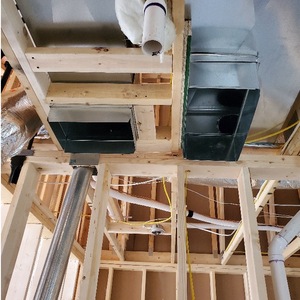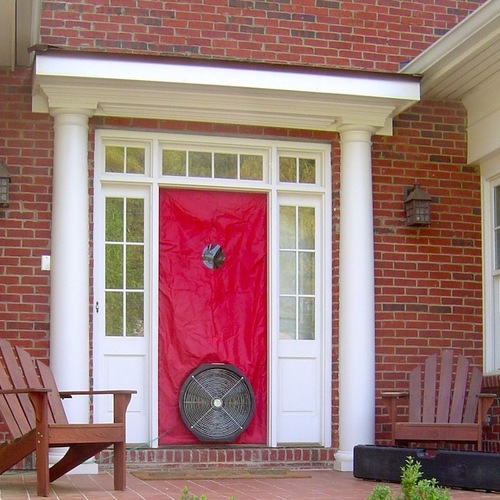Image Credit: Image #1: Public domain
Image Credit: Image #1: Public domain A hydraulic jack works by trading off a small force acting over a long distance with a large force acting over a short distance. Pascal's Principle says that the pressure exerted on one side of the fluid is transmitted undiminished to the other side.
Image Credit: Images #2 and #3: Energy Vanguard In a blower door test, the fan induces a pressure change, which is transmitted throughout the house. Leaks and the compressibility of air make it a little different from a hydraulic jack, but the basic principle is the same.
Remember the first time you ran a blower door? OK, maybe that’s not the best way to get where I’m going because most first-timers turn the pressure up like they’re practicing tai chi on Jupiter. After you’ve done a few tests, though, you learn to crank it up to 50 Pascals of pressure difference in just a few seconds. And that’s where you may have discovered the mystery that Blaise Pascal solved nearly four centuries ago when he invented the hydraulic press.
When you run a blower door and move air from indoors to outdoors, you’re decreasing the air pressure inside the house. At least you know that’s true right by the fan, because that’s where you set up the manometer to measure the pressure difference. If you’ve done any blower-door testing, you may have wondered if the pressure is really the same in other parts of the house and how long it takes for the pressure in the farthest reaches of the house to drop to the same level.
Of course, you could always do the experiment. Set up your blower door as usual on one side of the house. Set up a second manometer on the far side of the house with a way to see the results right there at the blower door. You could even use data loggers to record the blow-by-blow if you were so inclined. The solution lies in understanding how a hydraulic jack works.
How a hydraulic jack works
If you’ve ever raised your car with a hydraulic jack, you probably noticed how easy it was to lift a lot of weight. That’s because the jack multiplies your force. The diagram below illustrates how it works. You push down on Piston A and it moves a relatively large distance with a relatively small force. The physics of fluids allows you to trade off those two quantities.
On the other side, Piston B rises only a small distance but does so with great force. The amount of work done, force times distance, is the same on each side, though. It works just like a lever, but with a fluid instead of a stick.
Pascal’s Principle and blower doors
This is where our friend Monsieur Pascal comes in. He discovered what is now called Pascal’s Principle:
A change in pressure at any point in an enclosed fluid at rest is transmitted undiminished to all points in the fluid.
The hydraulic jack works because when you press down on Piston A, you increase the pressure in the fluid under the piston. That pressure is then transmitted right across to Piston B. And it happens right away because that pressure wave transmits to the other side at the speed of sound. It is a sound wave, in a sense, since both are pressure waves.
So when you turn on the blower door, Pascal’s Principle is what tells you the pressure you measure at the blower door will be the same as the pressure on the other side of the house. And it happens almost immediately… unless you have an unusually long house. If your house were, say, a mile long, it would take about 5 seconds for the pressure to reach equilibrium.
OK, strictly speaking, Pascal’s Principle applies to incompressible fluids that are completely enclosed. Air is compressible, but the pressures we’re working with in a blower door test don’t do much compressing. Also, houses aren’t airtight, so the leakier they are, the more pressure variation you’ll find, especially when you’re close to the leaks. Even in a leaky house, though, the pressure change you induce with the blower door transmits across the house at the speed of sound.
Happy birthday, Blaise Pascal!
Pascal’s birthday was last month, on June 19th. Although he didn’t make it even to 40 years old, he accomplished a lot in his short time. In addition to discovering Pascal’s Principle, he invented the hydraulic press and the syringe. He was one of the few who rejected the Aristotelian notion that a vacuum couldn’t exist, contradicting luminaries like René Descartes. He also helped advance the development of the scientific method by writing that falsifiability is a distinguishing feature of scientific theories. And then there’s every high school algebra student’s favorite Pascalism: Pascal’s Triangle.
Happy (belated) birthday, Blaise Pascal!
Allison Bailes of Decatur, Georgia, is a speaker, writer, energy consultant, RESNET-certified trainer, and the author of the Energy Vanguard Blog. Check out his in-depth course, Mastering Building Science at Heatspring Learning Institute, and follow him on Twitter at @EnergyVanguard.
Weekly Newsletter
Get building science and energy efficiency advice, plus special offers, in your inbox.
















6 Comments
Blaise Pascal was also a writer and philosopher
Allison,
Thanks for highlighting Blaise Pascal's scientific accomplishments.
As every French high school student knows, Blaise Pascal was also a writer and a philosopher. Some of his sentences were so well-crafted that they are still regularly quoted.
To illustrate the butterfly effect, Pascal made a reference to one of Mark Antony's love affairs:
"Le nez de Cléopâtre, s'il eût été plus court, toute la face de la terre aurait changé."
Or, in English: "Had Cleopatra's nose been shorter, the whole face of the world would have been different."
On intolerance:
"Les hommes ne font jamais le mal si complètement et joyeusement que lorsqu'ils le font pour des raisons religieuses. "
Or, in English: “Men never do evil so completely and cheerfully as when they do it from religious conviction.”
An example of accidental (or coincidental) Buddhism:
"J'ai découvert que tout le malheur des hommes vient d'une seule chose, qui est de ne savoir pas demeurer en repos dans une chambre."
("All men's miseries derive from not being able to sit in a quiet room alone.")
On the ways of the heart:
"Le cœur a ses raisons que la raison ne connaît point."
("The heart has its reasons of which reason knows nothing.")
Concrete contractors, however, will probably be drawn to this quote from L'Art de Persuader:
"Si l'on n'assure le fondement on ne peut assurer l'édifice."
("If we do not secure the foundation, we cannot secure the edifice.")
And
Don't forget Pascal's Wager
Response to Malcolm Taylor
Here is a link to more information on Pascal's Wager.
The wager centered on the question of whether belief in God is a sensible choice in light of the fact that the existence of God is unknowable. Pascal's conclusions depend on Christian beliefs that include the concept of spending eternity in heaven and hell.
Blaise and the stack effect
It's interesting that GBA posted this article, and one from Tamasin Sterner, within a few hours of each other. Tamasin asserts that pressures are not the same throughout the house, and seems to say that air will move from higher pressure to lower pressure, under some conditions. Allison, and his buddy Blaise, present a contrasting argument. It may take an additional article to clarify, in a way that is useful and practical for builders and designers, just how Blaise's Pascal Principle gets along with the stack effect.
Response to Derek Roff
I can see how it might be confusing, Derek, but the two are actually not in conflict. The pressure exerted by the blower door on the air throughout the house is transmitted a la Pascal's Principle. In an airtight house, the 50 Pa pressure difference is felt throughout. In a leaky house, the pressure difference won't be quite as high as you move away from the blower door, especially when you're near the leaks.
The stack effect was there before you turn the blower door on, though, and is still there afterward. If the stack pressure is 0 Pa at the bottom of the house and 5 Pa at the top of the house before you turn on the blower door, you'll end up with 50 Pa at the bottom and 55 Pa at the top with the blower door running (assuming an airtight house).
One interesting thing to note is that you cannot measure the stack effect pressure difference with a manometer. The reason is that the air in the tube is subject to the same pressure difference.
Blower door pressure dynamics
I enjoyed your quotes from Pascal but reluctantly I have to disagree with your conclusions. The difference in pressure in a building with a blower door does not equalize at the speed of sound. You refer to his statement “A change in pressure at any point in an enclosed fluid at rest is transmitted undiminished to all points in the fluid. The problem is the “at rest” part. A simple example that I believe demonstrates this is an automobile tire. Because of its small size sound will travel from the valve stem to the farthest point in a fraction of a second. I know when I add air to a tire it takes a lot longer than that to get the pressure to the value I want.
When you start the blower door it pulls the air touching it causing a drop in pressure. That pressure drop will cause the adjacent air to start moving toward the blower. This process repeats as you get farther and farther from the blower. I believe this is the pressure wave traveling at the speed of sound. The pressure in the building will start to change at the speed of sound but it will take longer to stabilize depending on factors such as the size of the building, the size of the blower, the pressure desired, and the amount of air leaking into the building.
Is there a difference in pressure between other places in the building and the pressure at the blower door? Yes, that is what causes the air to move toward the blower door. The more air leaking into the building the faster it moves and therefore the larger the pressure difference. If there was no difference in pressure the air would stop moving. Unfortunately I have not thought of a simple way to estimate how long it will take the pressures in a building to stabilize or how much the pressure difference will be. Hopefully someone will make some measurement and share the results.
Log in or create an account to post a comment.
Sign up Log in